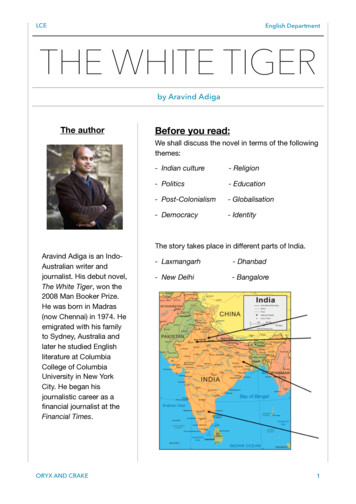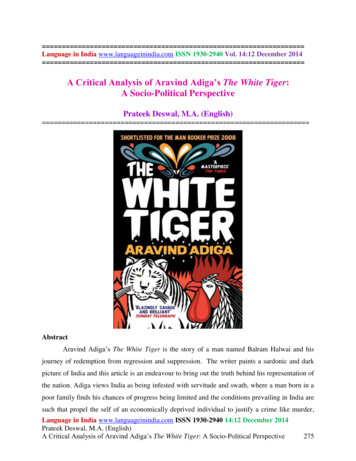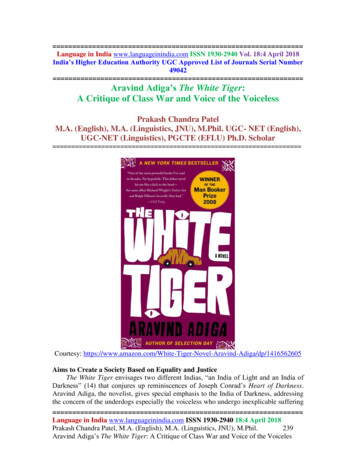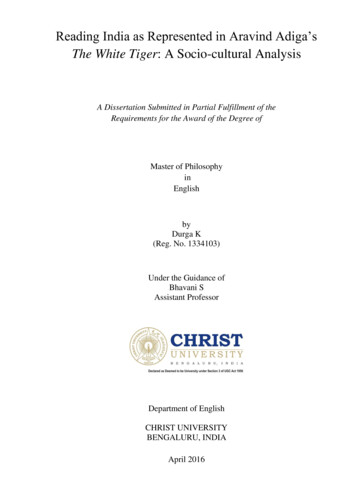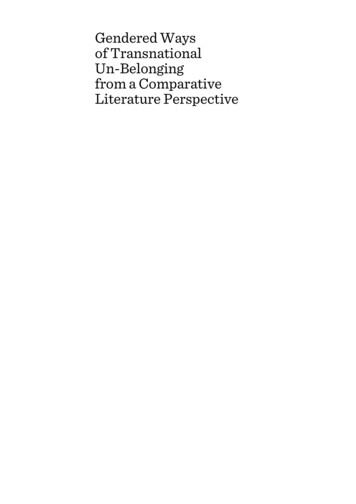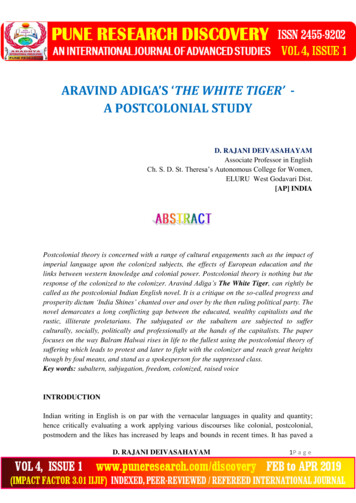
Transcription
ARAVIND ADIGA’S ‘THE WHITE TIGER’ A POSTCOLONIAL STUDYD. RAJANI DEIVASAHAYAMAssociate Professor in EnglishCh. S. D. St. Theresa‟s Autonomous College for Women,ELURU West Godavari Dist.[AP] INDIAPostcolonial theory is concerned with a range of cultural engagements such as the impact ofimperial language upon the colonized subjects, the effects of European education and thelinks between western knowledge and colonial power. Postcolonial theory is nothing but theresponse of the colonized to the colonizer. Aravind Adiga’s The White Tiger, can rightly becalled as the postcolonial Indian English novel. It is a critique on the so-called progress andprosperity dictum ‘India Shines’ chanted over and over by the then ruling political party. Thenovel demarcates a long conflicting gap between the educated, wealthy capitalists and therustic, illiterate proletarians. The subjugated or the subaltern are subjected to sufferculturally, socially, politically and professionally at the hands of the capitalists. The paperfocuses on the way Balram Halwai rises in life to the fullest using the postcolonial theory ofsuffering which leads to protest and later to fight with the colonizer and reach great heightsthough by foul means, and stand as a spokesperson for the suppressed class.Key words: subaltern, subjugation, freedom, colonized, raised voiceINTRODUCTIONIndian writing in English is on par with the vernacular languages in quality and quantity;hence critically evaluating a work applying various discourses like colonial, postcolonial,postmodern and the likes has increased by leaps and bounds in recent times. It has paved aD. RAJANI DEIVASAHAYAM1P a g e
way for cultural synthesis of various nations. Since the beginning of their career as writers in1930s, the Indian writers were much influenced by their colonial encounter with the British.In addition, their contact with the literature of other colonized countries made them presentthe humiliations and oppressions of the Indians under the colonial power which in turn madethe downtrodden to raise their voice and question their colonized status. Moreover the latetwentieth century has given rise to debatable issues regarding not only the key concepts ofpostcoloniality but also the term postcolonial itself. While agreeing to some extent with theviews of the critics that post colonialism intersects other literary theories like postmodernism,structuralism and feminism, Hutcheon points out that “what writes all these different, evenopposing positions on the meaning of the postcolonial is a shared stake in the psychologicaland social analysis of colonial identity on the collective and individual levels” ( Hutcheon,1995:11). The term postcolonial itself includes “all the cultures affected by the imperialprocess from thePostcolonial theory is concerned with a range of cultural engagements such as the impact ofimperial language upon the colonized subjects, the effects of European education and thelinks between western knowledge and colonial power. In other words, postcolonial theory isnothing but the response of the colonized to the colonizer. By appropriating the colonizer‟slanguage, the colonized tries to express his struggle over his identities of place, history, raceand culture, and also his struggle to voice the reality of his self through education he hadreceived to the global audience. Thus Aravind Adiga‟s The White Tiger, the Man BookerPrize winning novel published in 2008 can rightly be called as the postcolonial IndianEnglish novel. It is a critique on the so-called „progress and prosperity‟ dictum India Shineschanted over and over by the then ruling political party. Though criticized bitterly by theIndian elite that the book „had taken us back three decades‟, „focusing on everything that isbad and disgusting‟, Aravind Adiga in fact presents the real picture of the deprived sectionsin India; the poor masses who constitute over seventy percent of Indian population and theirperennial suffering in the society that is ruled by the privileged classes who constitute overtwenty percent of Indian population. Deprivation, loneliness, alienation, subjugation,resignation, and neglect mark their lives and relegate them to the status of the subaltern whocannot speak. They have no spokesperson to speak about them which forces them to sufferhelplessly and get no place at all in the history and culture of which they are the essentialpart. By depicting the life of the poor and the innocent, the author attacks the rotten politicalsystem, economic structure, degradation of moral values and increased corruption in everywalk of life in India. When the country goes through all these evils the author wonders howanyone could give a slogan like „India shines‟. He reiterates that the novel is nothing but anattack on the story of growth and development in India:At a time when India is going through great changes and with China, is likelyto inherit the world from the West, it is important that writers like me try toD. RAJANI DEIVASAHAYAM2P a g e
highlight the brutal injustices of society . Criticism by writers like Flaubert,Balzac and Dickens in the 19th century helped England and France to becomebetter societies. That’s why I am trying to do – it’s not an attack on thecountry, it’s about the greater process of self-examination.(Quoted by Krishna Singh).He further states that his novel “attempts to catch the voice of the men you meet as you travelthrough India – the voice of the colossal underclass. According to him, the novel was writtento capture the unspoken voice of the people from the “darkness” – the impoverished areas ofthe rural India, and he “wanted to do so with sentimentality or portraying them as mirthlesshumorless weaklings as they are usually” (Young, 2012). Though India claims to be in therace of becoming a super power due to its booming economy, it is still nearer to darkness.The author brings forth this dark side of India by highlighting a number of issues related tothe new world order such as multinational capitalism, global imperialism, class and castediscriminations, the myth of India shining or drowning etc.The White Tiger is a book about a man‟s quest for freedom. Balram Halwai works his wayout of his low social status and overcome the social obstacles that have limited his family inthe past to the fullest that he can. He uses the metaphor of the Rooster Coop to speak abouthis life in the city. “Go to Old Delhi . Hundreds of pale hens and brightly colored roosters,stuffed tightly into wire-mesh cages . They know they are next, yet they cannot rebel. Theydo not try to get out of the coop. the very same thing is done with humans in this country(147). The Coop represents life in the darkness: the life where roosters or the people cannotchoose their fate, where they live in poverty, where they see themselves and their families indeplorable conditions, where they inevitably will live and die without even thinking of anyescape. The novel is somewhat a memoir of his journey to finding his freedom in India‟smodern capitalist society. It is a record of his journey from the son of a rickshaw puller,himself an underdog working in a tea stall, to a successful industrialist in Bangalore mainlydue to the brutal killing of his employer Ashok Sharma and taking his name. By recording theimportant events in Balram‟s life, the author presents an authentic picture of the real India.Though he depicts two extreme sides of India - the Darkness and the Light – the author‟sfocus is more on a subaltern‟s rise from the darkness to the light though on a crooked notereflecting the double vision of our society.Born in India‟s overarching darkness of perpetual servanthood and poverty, Balram seeks alife in the light – a life of freedom and financial prosperity. Unlike the majority of the poor inIndia eternally pent up in the „Rooster Coop, he is ready to sacrifice his family for his owngain. His ambition and his inner drive propels him to commit murder to achieve freedom. Tobe one‟s own man one must break free from the darkness and live life by choosing his ownpath. In fact, it is his father who instills in him the thought of becoming a man , not to liveD. RAJANI DEIVASAHAYAM3P a g e
and die as a slave thus provoking him to pursue the goal of becoming one of those men in the„light‟. He says “my whole life I have been treated like a donkey. All I want is that one son ofmine – at least one – should live like a man” (26). In his pursuit of attaining freedom, heunderstands the real nature of casteism in India. “There are just two castes: men with BigBellies, men with Small Bellies. And only two destinies: eat or get eaten up” (54). Balramhas a big belly – filled with the lust of freedom and of riches – the same belly that eventuallyprovokes him to murder Ashok and give up his family for the sake of becoming a man.In this novel Balram looks different from the children with whom he had grown in his homeenvironment Lakshmangarh which stands for the rural India. Throughout the novel, he isreferred to as The White Tiger which symbolizes power in East Asian cultures. It also standsas a symbol for freedom and individuality. A White Tiger can never be a slave; it can only bethe master. It exercises power and beauty. Even a caged tiger shows its power and yearns forfreedom and it waits for the right time. „beauty‟ for Balram is nothing but financial prosperityand power in society. Though he lives in the midst of poor children in his school and latergets trapped in the darkness amid the poor masses who carry with them „small bellies‟Balram becomes the „White Tiger‟ who escapes from the life of bondage and slavery. Whenhe sees the caged tiger in the zoo, he gets hypnotized by its movements. For a while heidentifies himself with the caged tiger: “The tiger was hypnotizing himself by walking likethis – that was the way he could tolerate this cage” (237). After sometime when he feels thatthe tiger vanishes from the cage, he also wishes to put an end to his life of servitude. Hebecomes a changed man. He realizes that he should kill Ashok to become his own man andenter into the light of freedom. After killing Ashok with a broken liquor bottle, he shouts inexcitement: “I‟ve made it! I‟ve broken out of the coop!”(275). By resisting the life ofdarkness and by revolting against the oppressive forces, he enters into a life that gives him achance to choose his own fate. He enters into the shoes of Ashok: he becomes his own manas per the wish of his father. He frees himself from servitude and enters into the life ofindependence. In his new role as Ashok, Balram finds great success. He launches a taxiservice for call centre workers which he calls „White Tiger Technology Drivers‟. By bribingthe police, Balram gains influence and makes his business successful. Politically also, hebecomes so powerful that he covers a fatal accident through his connection with the politicaland government authorities. He considers himself to be a quintessential entrepreneur thatrepresents the future of India and presents himself as such to the Chinese Premier.Balram Halwai relates his story in the form of seven letters written to the Chinese PremierWen Jiabao in seven consecutive nights (but never posted) because he believes that “thefuture of the world lies with the yellow man and the brown man now that our erstwhilemaster, the white skinned man has wasted himself through buggery, mobile phone usage anddrug abuse” (Tiger, 5-6). Here he speaks about the shining India where there is rapid growthin the fields of science and technology, space, real estate, information technology, expansionD. RAJANI DEIVASAHAYAM4P a g e
of cities, emergence of multinational companies and successful entrepreneurial skills. “YouChinese are far ahead of us in every respect, except that you don‟t have entrepreneurs .Thousands and thousands of them. Especially in the field of technology. And theseentrepreneurs – we entrepreneurs have set up all these outsourcing companies that virtuallyrun America now.” (4). When he speaks about the brightness of the metropolitan cities, healso focuses on the dreary side of India – the darker side where there were crimes likemurder, manipulation, opportunism, corruption in all departments which are justified as partof path to success. Here Balram makes a prediction: “In twenty years‟ time, it will be just usyellow man and brown man at the top of the pyramid, and we‟ll rule the whole world”. (305).Ashok also feels the same about the future India. “Things have changed so much in India.There are so many more things I could do here than in New York . The way things arechanging in India now, this place is going to be like America in ten years”. (89) This way themetropolitan cities such as Delhi and Bangalore are found to be on the brighter side of Indiaat the outset; but in reality these cities are in the grip of corruption and abject poverty.Poverty-stricken people throng to the cities in search of work and a better place to live in; butthey merely end up living in the streets while the rich enjoy themselves in palatial buildingscompletely oblivious to the misery around them.Adiga‟s novels are quite provocative in the sense that the harsh realities that he depict in hisnovels prick the politicians, bureaucrats and the entrepreneurs who also play the role of kingmakers involved in amassing riches at the expense of the common man making themmarginalized. The India that Adiga presents consists of feudal landlords who are described asferocious animals devouring everything that comes their way and find delight in subjugatingand exploiting the poor. He gives the rich landlords the names of Buffalo, Stork, Wild BoarAnd Raven. Stork owns the river and feeds like leech on every fisherman by collectingcommission. Wild Boar, his brother, owns the rich agriculture land around Lakshmangarhwho feeds on the daily labourers working on daily wages. The Raven who owns the worst dryland squeezes the goatherds when they take their flocks for grazing in the hills. On the otherhand, Buffalo, the greediest of all, does not leave even the rickshaw pullers. He collectscommission from them for using the roads. They enjoy full support of the regional politicalparties as they also are the shareholders of this commission. The author presents theseexploitative situations as some of the reasons for the spread of naxalism. The exploited youthturn to naxalism and the poor become victimized at the hands of the police and thebureaucrats when there was a bloody fight between the naxals and the landlords who hadtheir own private armies. These goondas go around the villages torturing people who aresuspected of sympathizing with the naxals.Social equality and equal opportunity for everyone is still an unfulfilled dream in „the shiningIndia‟. Though Indian law vehemently emphasizes that there is no caste and classdiscriminations in India, caste system continues to be the major feature defining a person‟sD. RAJANI DEIVASAHAYAM5P a g e
social standing and reputation. Though most of the people appear to be broad-mindedregarding caste, it is in fact deep-rooted in their nerves. The old driver asks Balram “Whatcaste are you” (56). Stork also asks a similar question: “Halwai . What caste is that – top orbottom?”(62) A Muslim hides his identity by calling himself Ram Prasad to get a job asservant in Stork‟s house as he knows that his landlord does not like Muslims. He even goes tothe extent of asking his grandson, whose passion for cricket provokes him to call himselfAzharuddin, the former Indian Captain, “call yourself Gavaskar. Azharuddin is a Muslim.”(70). Most of the parents do not accept inter caste marriages. They either disown theirchildren or take extreme step of killing them in the name of family honour. In AndhraPradesh, recently one father of „upper caste‟ got his dalit son-in-law brutally murdered inbroad daylight as he had committed an unforgivable offence by marrying his daughter againsthis will. In another similar incident, the father killed his own daughter for disgracing thefamily by marrying a man of another community. These are just a few instances which speakvolumes of the impact of casteism in India. Politicians speak about a casteless and classlesssociety, but they would not practice it. Rather they exploit certain communities to come topower or to continue to be in power by bribing them with cash or kind. This is quite evidentin present day political scenario as well. The politicians in order to win the elections, bankon the votes of the underprivileged sections of society by bribing them.The novel demarcates a long conflicting gap between the educated, wealthy capitalists andthe rustic, illiterate proletarians. The subjugated or the subaltern are subjected to sufferculturally, socially, politically and professionally at the hands of the capitalists. They arehelpless to raise their voice and powerless to resist the exploitation and humiliation thrust onthem. Though they remain inarticulate, still they have strong desire to come out of theshackles that confine them for ages. They have the instinct of rebellion but they keepthemselves in check by remaining loyal to their masters. They become well acquainted to thelife style of their masters, their strengths and their weaknesses and then wait for anopportunity to hit back at the center. They also have the seeds of evils in them and these evilsfinally force them to challenge the existing order – the man-made order of discrimination onthe basis of caste and class – the oppressed revolt against the oppressor. When a subaltern isgiven voice, he\she can speak in a powerful language that can challenge the pillars ofestablished social order.In this novel, Adiga portrays the different images of India – India of Light and India of Darkbut his focus is more on the latter part. He attacks the affluent and corporate giants who as theuncrowned rulers of the country control the political leaders and the government officials andmake them act according to their whims and fancies. They hypnotize the general public bymaking them believe that the country they live in is „shining‟ with IT boom resulting inemployment for educated youth, increase of per capita income, economic growth andimprovement in financial status. But in reality, the people who belong to this category areD. RAJANI DEIVASAHAYAM6P a g e
very few compared to the majority of Indians who still struggle to make their both ends meet.They are the victims of oppression and subjugation: they are the subaltern that cannot speak.But if a subaltern raises his voice, if he starts questioning, what would be the end result? Thatis what Balram has done in this novel. On watching the world around him, on seeing thetreacherous ways in which people involve themselves in this „shining India‟, Balram decidesto shine. This is a way of protest against exploitation, and suppression of his class. As atypical voice of the colonized, he struggles to set himself free from age-old slavery andbondage. His anger and frustration make him protest and he gets involved in criminalactivities and vices of the society such as prostitution, drinking, grabbing all the opportunitiesthat come his way and even goes to the extent of killing his master and stepping into hisshoes thus having his last laugh. He stands for the exploited class. By highlighting thesubaltern issue, Adiga reiterates that if a country claims to be „shining‟ it has to deal with theproblems of „darkness‟, the sufferings and tribulations of the colonized and the suppressedand bring some noteworthy change in their lives. Then only can we hope to see India „trulyshining‟ at least in near future. Until then it remains only in words but not in action.Adiga, Aravind. The White Tiger. New Delhi: Harper Collins Publishers, 2008.Apte, Sudhakar Das. The Sunday Times of India. New Delhi: Oct. 19, @008.Singh, Krishna. Aravind Adiga‟s The White Tiger: The Voice of Underclass – A PostcolonialDialectics 2015.Hasan, Sheikh Mehedi. Darkness, Light and Beyond: Reading Aravind Adiga‟s The WhiteTiger. 2015.Wikipedia. Critical analysis on Aravind Adiga‟s The White Tiger. Reviews on The WhiteTiger.D. RAJANI DEIVASAHAYAM7P a g e
Balram becomes the „White Tiger‟ who escapes from the life of bondage and slavery. When he sees the caged tiger in the zoo, he gets hypnotized by its movements. For a while he identifies himself with the caged tiger: "The tiger was hypnotizing himself by walking like this - that was the way he could tolerate this cage" (237).

